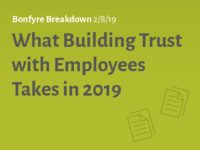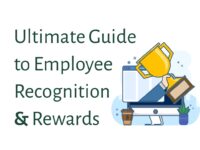Millennials have been given a bad rap for their tendency to change jobs. However, data tells us that job hopping is a multi-generational behavior and a symptom of misaligned expectations.
Millennial employees have gained a reputation for being notoriously flighty. Older generations have branded them “job hoppers,” a term with negative connotations that’s used to define employees who change jobs every two to three years.
To be clear, millennials do job hop, and out of all the generations in the workforce today, they’re the most likely to switch jobs. However, the reality is that job hopping is more an element of being young than a generational quirk.
Pew Research shows in 2016, 63.4% of millennial respondents aged 18-35 reported having been at their job for at least 13 months; in 2000, 59.9% of Gen X employees aged 18-35 reported a similar length of tenure at their jobs. As for Boomers, the Bureau of Labor Statistics reports that late Boomers (the generation born between 1957 and 1964) held an average of 11.9 jobs from age 18-50, with nearly half of those jobs held when they were ages 18-24.
The takeaway here is that young people, not just millennials specifically, are the ones who change jobs. It makes sense–younger employees generally have yet to get married or start families, and therefore have less need to stay at a job for benefits or financial reasons. But this leads to a deeper question. What spurs these young employees to leave what are ostensibly promising positions?
The real reason employees are job hopping
Employers can be quick to blame millennials for their job-hopping tendencies–they’re too impatient, too demanding, too entitled. But for the most part, millennial expectations aren’t that different than their predecessors. In fact, a survey by Qualtrics for CNBC reports that nearly 90% of millennials surveyed would stay at a company for the next 10 years if they knew they were going to receive annual raises and upward career mobility. Seventy percent said they’d also take a pay cut in exchange for guaranteed job security. Once again, we’re left wondering: if millennials want long-term job security, why are they job hopping?
The answer lies in the expectations the employee has and whether or not these expectations are known and being met by employers. According to Randstad, reaching career potential is important to workers, but most aren’t receiving the right tools or opportunities from employers. Fifty-eight percent of employees believe that their companies don’t have enough room for growth to warrant them staying long-term, 69% would like their skills and talents better utilized, and 57% say they think they need to leave their current companies in order to advance their careers.
This reveals a truth universal to all generations: employees who are job hopping do so because they feel they are missing out on something essential that their employer just isn’t providing–whether that’s in terms of individual purpose, pay raise and promotions, or professional development.
Aligning expectations for a better employee experience
As Tracey Maylett and Matthew Wride point out in The Employee Experience: How to Attract Talent, Retain Top Performers, and Drive Results, expectations are the foundation of employee experience.
Let’s track this to the very beginning. When a new hire starts at a company, they’ve already started building expectations. As they maneuver through onboarding and learn about their duties and the culture, they also start sizing up the company. They make an early judgment, based on formal and informal interactions, to determine the overall worth of their role and whether there is room for growth and development. Within a month or so, an employee usually knows if they’re a good fit and if they want to stay in that job for the long term.
In order to keep employees from job hopping, employers must understand and align expectations from the first day and throughout an employee’s time at a company. This is achieved by constant, transparent communication. Managers need to initiate a continuous dialogue about what an employee’s goals are, and they then have to fit those goals into the overall mission of the company. Matching the goals of the company to the individual goals of an employee provides a stronger connection to the bigger picture. Employees tend to be more invested in achieving goals when those goals benefit others, as well.
Related: Three Anchors for your Employee Experience Framework
Currently, millennials make up the largest portion of the workforce, Boomers are retiring at a rate of 10,000 individuals per day, and Gen Z is trickling into the workforce. These shifting tides in employee makeup mean an increased need for flexibility. To be prepared for these changes, employers have to start thinking about the employee experience and the expectations that shape it.
In The Employee Experience, Maylett and Wride give a glimpse of what it means to meet employee expectations: communications are honest and effective, the company culture is authentic, and engagement is high. The end result is desirable for everyone. When expectations are aligned, it means employees feel they’re getting what they want, employers see higher engagement and productivity, and customers are more satisfied. In other words, when expectations are met and the employee experience is positive, everyone wins.



 3 min
3 min




